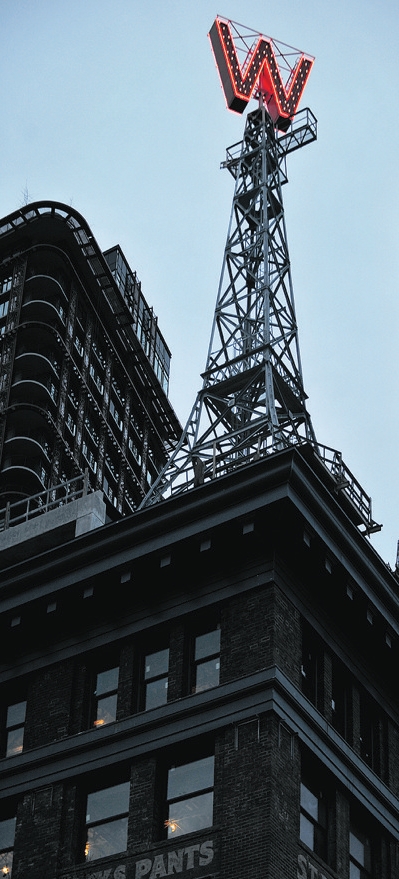Woodward’s an invitation for us all to experience a historic social re-integration
Bob Ransford
Sun

The ‘W’ sign is once again rotating above Abbott and Hastings in downtown Vancouver. The Downtown Eastside development has become a model for modern urban regeneration, columnist Ransford comments. Photograph by: Jenelle Schneider, PNG, Special to the Sun
The big red “W” -a rebuilt Vancouver icon on its Eiffel Towerlike base — marks ground zero for the rebirth of a real community in Vancouver’s Downtown Eastside.
The Woodward’s development, topped once again with the rotating “W”, is a model for modern urban regeneration, demonstrating the mix of uses, urban-design detailing and intentional diversification required to make a real neighbourhood with a real sense of community.
Many have taken issue with me in the past when I have suggested that the Downtown Eastside neighbourhood isn’t a real neighbourhood today.
Some of my strongest critics on this issue have been from among that small group of activists who believe that the disadvantaged deserve their own neighbourhood. They argue that their community’s identity is based on a strong culture.
No doubt a culture does exist in the neighbourhood. But there are some who constantly try to constrain the bounds of that culture so that it only embraces one class and celebrates poverty as a symbol of class struggle, resisting any change that suggests the kind of social integration that makes communities diverse, complete and strong.
Woodward’s pulls at those constraints. It pushes the bounds, not only those embraced by the protectors of the class struggle, but also those bounds self-defined by people outside the neighbourhood who see nothing but misery in the Downtown Eastside.
With its mix of high-end and moderately priced condos, its 225 units of social housing for families and the hard-to-house, all planned as part of a mixed-use development with a university mini-campus and cultural facility, pharmacy, grocery store, bank, coffee shop, dentist’s office, sandwich shop and a pub, Woodward’s has ignited the rebirth of what was once Vancouver’s city centre.
I spent a couple of hours walking through Woodward’s the other day, hanging out in the public space and shopping there when most other Vancouverites and our onslaught of Olympic visitors were preoccupied with the fun zones throughout the downtown. It was relatively quiet there, but welcoming.
That’s when it dawned on me that it’s not just the housing and the mix of commercial and educational uses at Woodward’s that are already helping make the Downtown Eastside a real neighbourhood.
The real key to Woodward’s success is its public spaces and the way they are already beginning to instigate the kind of social interaction that is needed for all of us to know each other and understand how we all fit together in the Vancouver we all cherish.
The inviting public realm and the generously scaled public gathering places in the Woodward’s project are the places that will welcome people of all means, all cultures, all backgrounds and from all parts of the city, night and day, encouraging the kind of social interaction that builds real community.
For the last few decades, the Downtown Eastside has lacked well-designed and well-maintained public places that attract a diverse people and make them feel welcome, comfortable and safe. Litter-strewn sidewalks on busy thoroughfares fronted by boarded-up, decaying buildings are not places people want to hang out — unless you have no other choice or unless you are a dope pedlar preying on those who have few choices in life.
Woodward’s has spaces that will attract people — all kinds of people — and those are places where people will once again feel comfortable in this special part of Vancouver.
One of the most impressive and welcoming spaces is a well-proportioned atrium tucked between three main buildings, protected from the weather, but designed to feel very much like an outdoor plaza. The space feels comfortable because of its generous but contained size, its abundance of natural light, the engaging public art and the active retail areas that front on a space protected from the rain, but open enough that it feels like a street.
There are other well-designed public spaces in the Woodward’s project, like the courtyard on which the SFU Contemporary Arts Centre faces, and the new Cordova and Hastings Street frontages.
I discovered something profoundly ironic when I visited the “Downtown Eastside Connect Centre” in the Woodward’s project the other day.
The Connect Centre is a drop-in display centre targeting the international media in town for the Olympics. The Centre showcases the many partnerships that have been built and the investments made by the provincial government, City Hall, Vancouver’s corporate community and more than 30 non-profit groups to address quality-of-life issues like housing, social services and economic development in the Downtown Eastside.
Among the exhibits and information displays at the Connect Centre was one that advertised a so-called “living library”. The library, operated by the non-profit agency Atira Women’s Resource Centre, offers 30-minute appointments with select residents and workers from the Downtown Eastside (the “books”) to engage in dialogue with visitors to the neighbourhood (the “readers”) to openly discuss prejudices and stereotypes and to tell their stories. It is a contrived way for people of different social classes and different backgrounds to get to know each other.
The irony was that this artificial attempt at facilitating social interaction — the kind of interaction that occurs naturally in diverse neighbourhoods — is being advertised in a space within a new neighbourhood centre that has the potential to encourage much more authentic and real social interaction.
Bob Ransford is a public affairs consultant with Counterpoint Communications Inc. He is a former real estate developer who specializes in urban land use issues. E-mail: [email protected]
© Copyright (c) The Vancouver Sun
